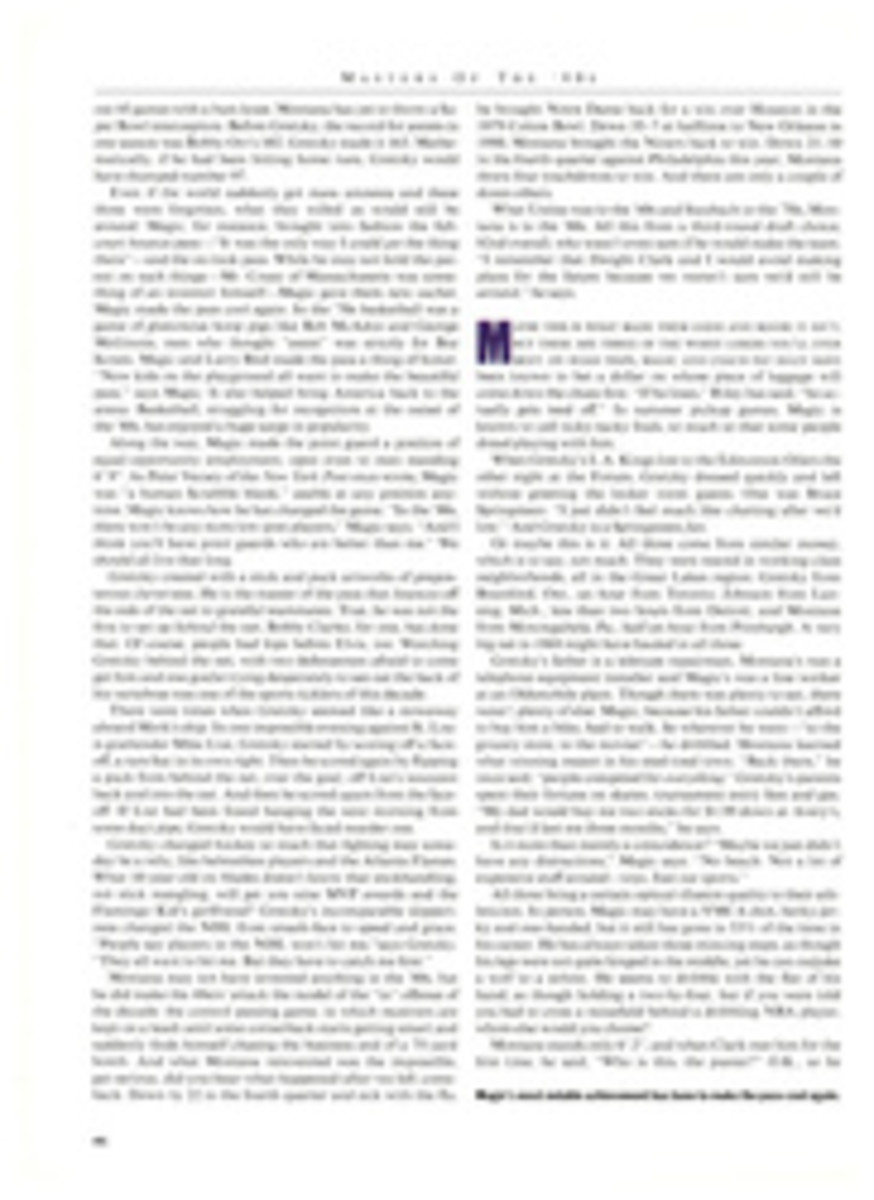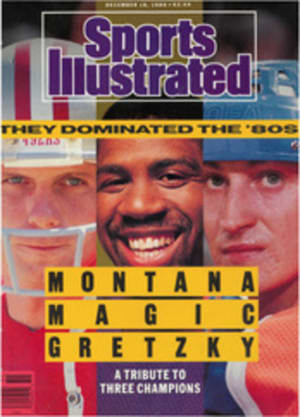
HAVE BALL, WILL TRAVEL
It was six hours before my flight would leave for Portugal, and I was finishing my packing, searching for a spot to stuff my basketball. Actually, my Wilson Pro 1000 hardly looked like a basketball anymore. Bled of its air, smashed flat as a Frisbee and squeezed between my shirts and sweaters, that poor piece of rubber made me wonder if it would ever bounce again. I also wondered if the inflation needle tucked in my wallet would set off the airport's metal detectors. And I wondered how I would explain if it did.
Allow me to try to explain now.
I'm a 36-year-old man with a fairly respectable job—newspaper reporting. I've got a wife and a daughter, a new car and an old truck, a mortgage and a few other odds and ends that should indicate I'm pretty much of a responsible grown-up.
But when it comes to street basketball, I'm still the kid I was at 12. I can't resist the sight of an open net and a decent run. It's playground ball I'm talking about, on an asphalt court under a clear sky, where the game is shirts and skins, where winners stick and losers sit and all men are created equal until separated by the sureness of their jump shots and the grace of their give-and-gos.
This is basketball at its purest, the universal pickup game. It is social—there is no better introduction to a stranger than a swift feed for an open layup. It is constant—a lot of things have changed in my life since I was 12, but rims are still 10 feet high. And it is fairly portable—all that's needed is a hoop, the bodies and a ball. And my ball has been around: on the beach at Laguna, where the backboards sit by the sand and the full-court runs are as fierce as the Southern California sun; in the shadow of downtown Chicago's John Hancock building, where the game is half-court, the body banging is brutal and the wind whipping off Lake Michigan turns the truest jumper into a sick joke; at the foot of Colorado's Summit County ski slopes, two miles above sea level.
But Portugal—that would be a challenge. What I knew of Portugal amounted to scattered snippets, images of ancient sea explorers and leather-skinned fishermen speaking what I had been told was one of the more tongue-twisting languages on earth. This would be the place to test my notions of the playground game's essence—if I could find a playground and if I could find a game.
Lisbon looked like a place in which to find both. From the air, the city was a sea of sun-soaked pastel houses, whitewashed apartment buildings with flowered balconies, tree-shaded squares and medieval stone battlements, all spilling down steep hillsides to the wharves on the river Tagus. More than two million people live in Lisbon. Its pro basketball team is considered competitive in its league. Surely one could find a game.
But I wasn't headed for Lisbon. I was flying north to the city of Porto, then driving up the coast almost to the Spanish border, where I would vacation for two weeks, using as my home base a friend's sister's villa near the fishing village of Caminha. This northwest corner of the country—the Minho province, named after the river that separates it from Spain—is the nation's most rugged region, and its most unchanged. This is where the Portuguese come to see how they used to live. Busloads of native tourists hurtle up the narrow oceanside highway to the Costa Verde, or "Green Coast," to get a glimpse of the old way of life that is kept alive in rural Minho.
And that is what I saw as I made my way north. I watched old women, draped in black, driving huge oxen that pulled the same type of wooden-wheeled carts used a thousand years ago. Ancient granite walls lined the cobblestone roadways that snaked through the vine-covered hills, and grape arbors were everywhere, held aloft by slabs of that same granite. At nearly every bend there were roadside shrines, small stone altars festooned with fresh flowers where people could rest and pray.
The people work hard, tending their vines with sickles and saws, mowing their fields with scythes, fishing in colorful wooden boats powered by muscle and oars. And they know how to rest, retreating for an hour at noon to the closest bar—bars are nearly as numerous along the roads of the Minho as shrines—for a cup of espresso laced with a shot of moonshine made from the skins of the grapes.
But I was also interested to learn what games the Portuguese play. Men in well-worn berets tossed darts in dark taverns whose stone floors were kept spotless despite the constant presence of prowling dogs, which are as welcome in these establishments as their masters. In the town of Viana do Castelo, I watched long-haired, bearded young men linger over lazy sessions of billiards played on long, narrow tables with pockets barely wide enough to slip a ball through. And on a bright, breezy weekend afternoon, I happened on a streamside festival; teens danced in the dirt to a Rolling Stones tape while a group of men were gathered by a Roman bridge to play a game older than that bridge—quoits, which is an ancient form of horseshoes.
Then, of course, there is soccer. Every village in Portugal has a sign pointing toward the town's campo de jogos, the "game field." Most are nothing but mowed weeds, two goals and maybe a fence. In the afternoons, when school is out, the fields come alive with boys—no girls—and balls. Soccer in Portugal begins at home. In the doorways of the most rural mountainside huts, boys practice dribbling their soccer balls the way their American counterparts bounce basketballs on city streets and suburban driveways.
I saw no basketballs my first week. Even finding a hoop took time. Not until my second week did I see a backboard. It was pitiful, set at the side of a walled schoolyard in the riverfront village of Vila Nova de Cerveira, where I was waiting for a ferry to Spain. The hoop was maybe nine feet high, bent at a grotesque angle and totally ignored by the children running past it playing tag and soccer. I didn't bother reaching for my Nikes.
The next afternoon, while trying to find my way into the medieval fortress that towers above the Spanish city of Tuy, I looked below and saw a court next to what seemed to be a high school. But there was no game. The gray sky was beginning to drizzle, and again I left my ball and shoes in the trunk.
Toward the end of my stay I had slipped into the relaxed rhythm of the Costa Verde's summer days, but I still had not found a game. I was getting desperate. This was no longer a gentle journey of discovery. It was now a matter of pride. I didn't pack that basketball for nothing. If it meant no more than shooting by myself at that sad hoop in Vila Nova, I was determined to do it.
Which is what I was thinking as I drove a car full of friends back from a day trip to the Spanish city of Santiago, where Catholic pilgrims still come by foot from across Europe to gaze at bone fragments of Saint James in the basement of the downtown cathedral. We were taking the long way home, down the coast to see the Spanish villages around the Bay of Vigo. With the sun setting pink over the water, we came into the town of Bayona, looking for a cafè, when there, tucked between the walls of yet another stone fortress and the waves of the dark Atlantic, appeared a concrete basketball court. Better yet, there were four teenagers going two-on-two. I hit the brakes, leaving my friends to fend for themselves. The teens were chattering in Spanish as I approached, slapping and hooting as they launched their shots. Three of them had games hardly worth mentioning, but the fourth, a lefty in an orange soccer shirt, could play. I watched him go through his legs with his dribble. Smooth. Head up. When the kid covering him backed off, lefty pulled up and, silhouetted against the castle wall, banked in a soft 12-footer. Then he stopped and turned toward me. It was a pause and a look all five of us understood. Was I here to watch or to play? I handed my camera to one of the kids, moved onto the court and motioned to lefty to bring it on. He smiled at his friends, bounced the ball a couple of times, then took it toward the hole.
I didn't expect that the game I would find in Iberia would be much different from the one I played at home. And it wasn't. These kids were about as good as any teens shooting in street clothes should be. Lefty was somewhat better. As I turned back toward my car after 15 minutes—long enough to have worked up a thin sheen of sweat—he nodded, grinned and, in English that startled me, said, "Veddy goot!" Then he threw me a gentle high five.
I never did find a game in Portugal. But I did go back to that court in Vila Nova, where I strung a net that I had brought and shot baskets alone for about half an hour, while amused passersby stopped and stared at this foreign man on their children's playground. I left the net on that Vila Nova rim. I hope it's still there. I couldn't find a player in the Minho, but maybe it will.
TWO ILLUSTRATIONS
PETER DE SÈVE
Mike D'Orso writes for the "Virginian-Pilot" and "The Ledger-Star" in Norfolk, Va.

